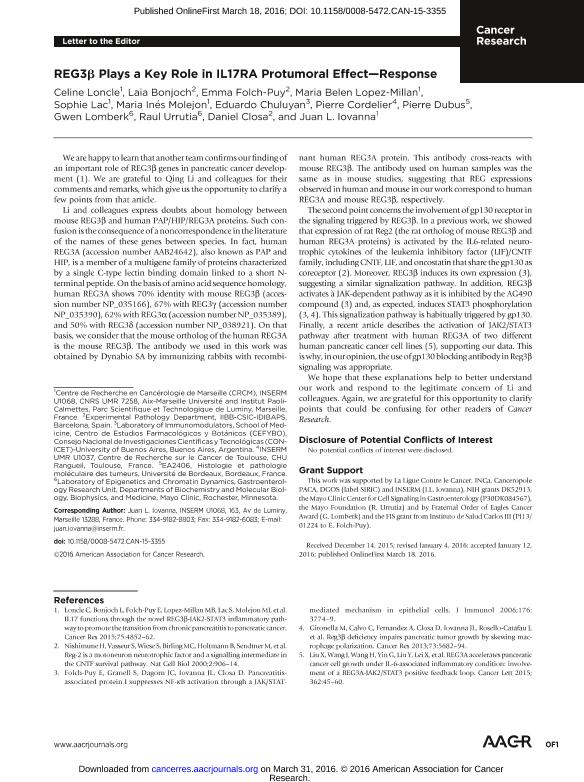Artículo
REG3β plays a key role in IL17RA protumoral effect-response
Loncle, Celine; Bonjoch, Laia; Folch Puy, Emma; Lopez Millan, Maria Belen; Lac, Sophie; Molejon, Maria Ines ; Chuluyan, Hector Eduardo
; Chuluyan, Hector Eduardo ; Cordelier, Pierre; Dubus, Pierre; Lomberk, Gwen; Urrutia, Raul; Closa, Daniel; Iovanna, Juan L.
; Cordelier, Pierre; Dubus, Pierre; Lomberk, Gwen; Urrutia, Raul; Closa, Daniel; Iovanna, Juan L.
 ; Chuluyan, Hector Eduardo
; Chuluyan, Hector Eduardo ; Cordelier, Pierre; Dubus, Pierre; Lomberk, Gwen; Urrutia, Raul; Closa, Daniel; Iovanna, Juan L.
; Cordelier, Pierre; Dubus, Pierre; Lomberk, Gwen; Urrutia, Raul; Closa, Daniel; Iovanna, Juan L.
Fecha de publicación:
04/2016
Editorial:
American Association for Cancer Research
Revista:
Cancer Research
ISSN:
0008-5472
Idioma:
Inglés
Tipo de recurso:
Artículo publicado
Clasificación temática:
Resumen
We are happy to learn that another team confirms our finding of an important role of REG3β genes in pancreatic cancer development (1). We are grateful to Qing Li and colleagues for their comments and remarks, which give us the opportunity to clarify a few points from that article.Li and colleagues express doubts about homology between mouse REG3β and human PAP/HIP/REG3A proteins. Such confusion is the consequence of a noncorrespondence in the literature of the names of these genes between species. In fact, human REG3A (accession number AAB24642), also known as PAP and HIP, is a member of a multigene family of proteins characterized by a single C-type lectin binding domain linked to a short N-terminal peptide. On the basis of amino acid sequence homology, human REG3A shows 70% identity with mouse REG3β ( accession number NP_035166) , 67% with REG3γ (accession number NP_035390) , 62% with REG3α (accession number NP_035389) , and 50% with REG3δ (accession number NP_038921). On that basis, we consider that the mouse ortholog of the human REG3A is the mouse REG3β. The antibody we used in this work was obtained by Dynabio SA by immunizing rabbits with recombinant human REG3A protein. This antibody cross-reacts with mouse REG3β. The antibody used on human samples was the same as in mouse studies, suggesting that REG expressions observed in human and mouse in our work correspond to human REG3A and mouse REG3β, respectively.The second point concerns the involvement of gp130 receptor in the signaling triggered by REG3β. In a previous work, we showed that expression of rat Reg2 (the rat ortholog of mouse REG3β and human REG3A proteins) is activated by the IL6-related neurotrophic cytokines of the leukemia inhibitory factor (LIF)/CNTF family, including CNTF, LIF, and oncostatin that share the gp130 as coreceptor (2). Moreover, REG3β induces its own expression (3), suggesting a similar signalization pathway. In addition, REG3β activates à JAK-dependent pathway as it is inhibited by the AG490 compound (3) and, as expected, induces STAT3 phosphorylation (3, 4). This signalization pathway is habitually triggered by gp130. Finally, a recent article describes the activation of JAK2/STAT3 pathway after treatment with human REG3A of two different human pancreatic cancer cell lines (5), supporting our data. This is why, in our opinion, the use of gp130 blocking antibody in Reg3β signaling was appropriate.We hope that these explanations help to better understand our work and respond to the legitimate concern of Li and colleagues. Again, we are grateful for this opportunity to clarify points that could be confusing for other readers of Cancer Research.
Archivos asociados
Licencia
Identificadores
Colecciones
Articulos(CEFYBO)
Articulos de CENTRO DE ESTUDIOS FARMACOLOGICOS Y BOTANICOS
Articulos de CENTRO DE ESTUDIOS FARMACOLOGICOS Y BOTANICOS
Citación
Loncle, Celine; Bonjoch, Laia; Folch Puy, Emma; Lopez Millan, Maria Belen; Lac, Sophie; et al.; REG3β plays a key role in IL17RA protumoral effect-response; American Association for Cancer Research; Cancer Research; 76; 7; 4-2016; 2051
Compartir
Altmétricas



